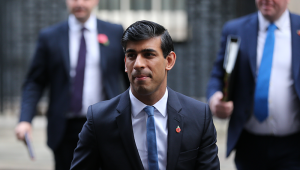Chancellor Philip Hammond held out the prospect of announcing more public spending in his autumn Budget.
But the IFS said UK public finances faced substantial pressures that must be addressed whether or not the government meets its target of eliminating the deficit by the mid-2020s.
Deputy director Carl Emmerson said at a briefing on the statement today that national debt was falling but was still at twice its pre-crisis share of national income.
He said the scope for spending more of tax revenue on public services could be limited because there were fewer taxpayers.
The increases in income tax thresholds and other reforms meant that only 56% of adults paid income tax, against 66% in 2007–08.
Just 1% of income tax payers contributed 28% of this revenue source, making it highly sensitive to any change in their circumstances, and a significant number were EU nationals who might depart after Brexit.
Hammond said yesterday that he would this autumn set out the parameters for a Spending Review in 2019.
Emmerson noted budget forecasts implied day-to-day departmental spending over the three years to 2022–23 falling in real per-capita terms by 2%, something he said would cost an extra £7bn if a political decision were taken to avoid such cuts.
There were pressures to do so because of clear signs of strain in public services - in particular in the NHS, prison service and local government - which had markedly worsened over the past two years, Emmerson noted.
IFS director Paul Johnson said the Spring Statement came near the tenth anniversary of the last pre-crisis Budget, since when the economy had broken records for poor performance and showed little sign of generating enough growth to significantly raise public spending.
“The deficit this year is projected to come in about £4bn less than expected in the autumn, and about £13bn less than projected in the March 2017 Budget,” Johnson said.
“That is good news, largely driven by better than expected tax receipts. That good news largely washes out over the next few years, however.”
He said the structural deficit in 2019-20 was “almost unchanged” and despite the economy being £300bn smaller than pre-crisis forecasts suggested, it now lacked the spare capacity to grow.
“Growth projections remain very subdued,” he said. “At no point in the next five years does the OBR believe that annual growth will exceed 1.5%.”
Although borrowing was now down to pre-crisis levels, UK growth prospects remained among the worst in the G20 and Brexit uncertainties meant, “there remains plenty of risk on the downside”.
Hammond’s greatest challenge in this context would be to “balance growing demands for spending increases against his desire to balance the books in the mid-2020s, “ Johnson said.
He noted many public services “are struggling in a way that they were not two or three years ago”, and “local government, having done a remarkable job of coping with cuts, is showing the strain”.
It was unclear where money would come from to meet pay awards above the now-abolished 1% cap, while substantial cuts to working age benefits had yet to take effect.











